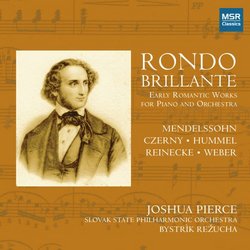| All Artists: Mendelssohn; Czerny; Hummel; Reinecke; Weber, Bystrik Rezucha, Slovak State Philharmonic Orchestra, Joshua Pierce (piano) Title: Rondo Brillante - Joshua Pierce Members Wishing: 0 Total Copies: 0 Label: MSR Classics Original Release Date: 1/1/2006 Re-Release Date: 4/25/2006 Genre: Classical Styles: Opera & Classical Vocal, Forms & Genres, Concertos, Historical Periods, Classical (c.1770-1830), Romantic (c.1820-1910), Instruments, Keyboard Number of Discs: 1 SwapaCD Credits: 1 UPC: 681585119624 |
Search - Mendelssohn; Czerny; Hummel; Reinecke; Weber, Bystrik Rezucha, Slovak State Philharmonic Orchestra :: Rondo Brillante - Joshua Pierce
 | Mendelssohn; Czerny; Hummel; Reinecke; Weber, Bystrik Rezucha, Slovak State Philharmonic Orchestra Rondo Brillante - Joshua Pierce Genre: Classical
The early romantic period was the heroic age of pianism. Every parlor had its piano and every well-brought-up young lady took lessons from as handsome, as poetic, and as swashbuckling a budding piano virtuoso as her family... more » |
Larger Image |
CD Details
Synopsis
Product Description
The early romantic period was the heroic age of pianism. Every parlor had its piano and every well-brought-up young lady took lessons from as handsome, as poetic, and as swashbuckling a budding piano virtuoso as her family could afford. These young lions wrote easy pieces for their still younger charges and showy, difficult-sounding pieces for themselves to play in public ? with orchestra if possible. Some of these show pieces were simply designated Concertstück (like the pianists themselves, most of whom seemed to be named Carl, this could be spelt with a ?C? or a ?K?,). The title can be translated either as ?Concert Piece? or ?Concerted Movement? and the form itself can be somewhat unconventional. Another popular title and a more specific musical type is the Rondo, a old and traditional musical format newly minted under the glittering French or Italian title of ?Brillant? or ?Brilliante?. The rondo itself started out as the rondeau of French poetry. Later, Italianized as rondo (or, more properly rondò), it became the favorite finale form in classical music and, starting in the French baroque and continuing well into the 19th century, often appeared as an independent solo keyboard piece. In all cases, the hallmark of the rondo is that it keeps returning to its main tune or refrain after excursions to other themes and keys (usually diagrammed as ?ABABA,? ?ABACABA? or something similar). In the early romantic period, the rondo brillant came to designate a popular keyboard piece ? solo or with orchestra ? designed to show off the nimble and flying fingers of our handsome and dashing virtuoso soloist. Rondo brillant becomes almost a category unto itself with its highly ornamented slow introduction, the fast tempo of its main section and the highly decorated solo part with its mixture of style and showoff; the form is usually a ?rondo sonata? rather than a classic rondo. A calculated mixture of elegance and graciousness on the one hand and flying finger flash on the other is typical of the age; the combination of grazioso and brillante might almost be said to sum up the esthetic of early romantic pianism.

 Track Listings (5) - Disc #1
Track Listings (5) - Disc #1